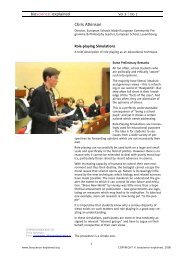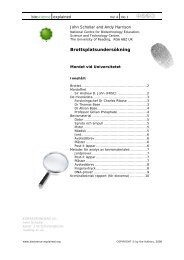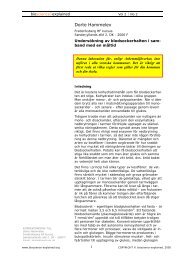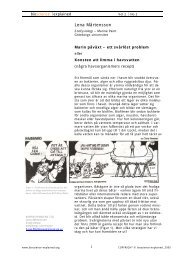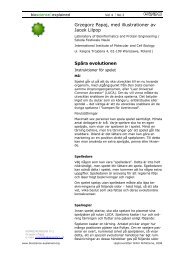Bioscience Explained | Vol 1 | No 1
Bioscience Explained | Vol 1 | No 1
Bioscience Explained | Vol 1 | No 1
You also want an ePaper? Increase the reach of your titles
YUMPU automatically turns print PDFs into web optimized ePapers that Google loves.
ioscience | explained <strong>Vol</strong> 1 | <strong>No</strong> 1<br />
CORRESPONDENCE TO<br />
John Schollar<br />
National Centre for Biotechnology<br />
Education, The University of Reading,<br />
Whiteknights, Reading RG6 6AP<br />
The United Kingdom.<br />
J.W.Schollar@reading.ac.uk<br />
www.bioscience-explained.org<br />
John Schollar<br />
The University of Reading<br />
Adapted from a model of unknown origin from 1959*<br />
Modelling the helix<br />
A cut-out 3-D model of DNA<br />
Aim<br />
This stunning cut-out 3-D model of DNA can be used to learn about<br />
the structure of B-DNA.<br />
Equipment and materials<br />
Needed by each person or group<br />
• Nucleotide templates, copied onto card from the following pages<br />
• Scissors<br />
• Bodkin or strong needle, for punching holes through card<br />
• Paper glue<br />
• Drinking straws<br />
• Fine string<br />
• Crayons (if coloured prints of the following pages are not used)<br />
• OPTIONAL: Sharp craft knife and cutting board<br />
Procedure<br />
1 Make several copies of the nucleotide templates on card. Ten<br />
nucleotide pairs are required for a complete turn of the double<br />
helix. To see the major and minor grooves in the double helix clearly,<br />
the model needs to have at least 16 nucleotide pairs.<br />
2 If colour copies have not been used, colour in the card<br />
appropriately. The colours that are often used in sequencing<br />
markers for DNA bases are: Cytosine=Blue; Guanine=Yellow;<br />
Adenine=Green; Thymine=Red.<br />
3 Cut out the nucleotide pairs around the thicker, outer lines. Make<br />
two small cuts into the card by the phosphate groups where<br />
indicated. OPTIONAL: Use a sharp craft knife to make cuts above<br />
the deoxyribose molecules where shown.<br />
4 Carefully punch a small hole in each cut-out where shown. This will<br />
be the axis of the DNA model through which the string will be<br />
threaded. Don’t make these holes too big!<br />
5 Fold the sugar-phosphate ‘backbones’ where indicated by dotted<br />
lines. These folds must be made in the directions shown on the<br />
accompanying pages. Take care not to make left-handed DNA!<br />
* The model upon which this one is based was brought to the author’s<br />
attention by Dr Cheong Kam Khow of the Singapore Science Centre. We have<br />
no idea of its origins other than a cryptic copyright note ‘© V.R.P. 1959’. If you<br />
are V.R.P., please contact us as we’d like to give you credit for this magnificent<br />
model, which evidently pre-dated most peoples’ interest in DNA.<br />
1 COPYRIGHT © BIOSCIENCE EXPLAINED, 2001
ioscience | explained <strong>Vol</strong> 1 | <strong>No</strong> 1<br />
www.bioscience-explained.org<br />
6 Cut 25 mm lengths of drinking straw. You will need one less piece of<br />
straw than you have nucleotide pairs.<br />
7 Glue the phosphate group on one cut-out onto the deoxyribose on<br />
the next. Do the same with the opposite sugar–phosphate strand.<br />
Remember that the sugar-phosphate chains run in opposite (antiparallel)<br />
directions. The orientation of the letters on the card should<br />
help you to assemble the model correctly.<br />
8 Hold a piece of drinking straw between the holes in the cut-outs,<br />
and thread the string through them.<br />
9 Repeat steps 5–8 for as many nucleotide pairs as desired.<br />
10 Cut out the genetic code, and glue the two side together onto the<br />
string at the bottom of the model.<br />
Timing<br />
It will take the average person about 90 minutes to assemble a model<br />
of 16 nucleotide units.<br />
Further activities<br />
Photocopy or print the nucleotide pairs into overhead transparency<br />
sheets instead of card. These can be assembled to make a particularly<br />
attractive model.<br />
Computer modelling<br />
RASMOL is a 3-D molecular modelling programme for Macintosh,<br />
Windows, UNIX and VMS operating systems. It was written by Roger<br />
Sayle and can be downloaded free-of-charge from the RASMOL Web<br />
site (http://www.umass.edu/microbio/rasmol).<br />
It is a good idea to print out RASMOL’s 40-page manual (which comes<br />
with the programme), as although RASMOL is easy-to-use, to make the<br />
most of it you will need to use the commands described in the manual.<br />
Molecules can be depicted in several different forms and coloured,<br />
highlighted and labelled in many ways (for example, to show the<br />
general motifs that comprise a protein). It is easy to rotate molecules<br />
and zoom in on parts to examine their structures in detail.<br />
The CHIME plug-in (details of which can be found at<br />
the RASMOL Web site) can be used to view<br />
molecular structures within the Netscape Web<br />
browser. The image on the left comes from a<br />
complete suite of animated, interactive CHIME<br />
pages designed to help students learn about the<br />
structure of DNA. It can be viewed or downloaded<br />
entirely (for viewing off-line) from: http://<br />
www.umass.edu/microbio/chime/dna/.<br />
2 COPYRIGHT © BIOSCIENCE EXPLAINED, 2001
ioscience | explained <strong>Vol</strong> 1 | <strong>No</strong> 1<br />
O -<br />
O -<br />
P<br />
O<br />
O<br />
CH 2<br />
P<br />
DOWN<br />
www.bioscience-explained.org<br />
O<br />
H<br />
O<br />
O<br />
CH 2<br />
MODEL’S<br />
AXIS<br />
O<br />
O<br />
O<br />
H<br />
N<br />
UP<br />
H<br />
N N H<br />
N<br />
N<br />
N<br />
N<br />
O<br />
A T<br />
NHN<br />
N<br />
H<br />
H<br />
H<br />
H<br />
G C<br />
O<br />
N<br />
O<br />
H<br />
N<br />
N<br />
O<br />
IMPORTANT!<br />
Take care not to make left-handed DNA.<br />
CH 3<br />
Phosphate groups on the left side fold DOWN, phosphates on the<br />
right fold UP.<br />
N<br />
N<br />
3 COPYRIGHT © BIOSCIENCE EXPLAINED, 2001<br />
H<br />
H<br />
O<br />
O<br />
O<br />
O<br />
O P O -<br />
O<br />
CH 2<br />
O P O -<br />
O<br />
CH 2
ioscience | explained <strong>Vol</strong> 1 | <strong>No</strong> 1<br />
- O<br />
P- O<br />
CH 2<br />
www.bioscience-explained.org<br />
O<br />
O<br />
H<br />
N<br />
N<br />
N<br />
C<br />
N<br />
G<br />
N<br />
O<br />
4 COPYRIGHT © BIOSCIENCE EXPLAINED, 2001<br />
O<br />
O<br />
- OP<br />
H<br />
O<br />
H<br />
O<br />
O<br />
CH 2<br />
O<br />
O<br />
H<br />
H<br />
N<br />
H<br />
O<br />
TH<br />
N<br />
A<br />
N<br />
N<br />
N<br />
H<br />
O<br />
O<br />
CH 2<br />
O<br />
O<br />
- OP<br />
H<br />
O P<br />
H 3C<br />
O<br />
H<br />
O<br />
N<br />
N<br />
H<br />
O<br />
N<br />
N<br />
N<br />
H<br />
O<br />
CH 2
ioscience | explained <strong>Vol</strong> 1 | <strong>No</strong> 1<br />
Cut these pieces out and glue them<br />
together back-to-back on the string<br />
below the model.<br />
www.bioscience-explained.org<br />
val<br />
arg<br />
ser<br />
lys<br />
ala<br />
asn<br />
asp<br />
thr<br />
glu<br />
gly phe leu<br />
ile<br />
arg<br />
gln<br />
ser<br />
A G T C A G T<br />
C<br />
C<br />
A<br />
T<br />
G<br />
G<br />
T<br />
A<br />
C<br />
C C A<br />
A<br />
T T<br />
G<br />
G<br />
G<br />
T<br />
A<br />
C T<br />
C G<br />
A<br />
T<br />
G<br />
G A C A C T<br />
A<br />
C<br />
C<br />
A<br />
T C<br />
A G<br />
G<br />
T<br />
A T G<br />
C<br />
C T<br />
G A<br />
T<br />
G<br />
G G<br />
T T<br />
A<br />
C<br />
A C<br />
C<br />
A<br />
T<br />
G<br />
G<br />
A<br />
T<br />
C<br />
C<br />
T<br />
A<br />
G A C T G<br />
met<br />
or<br />
START<br />
www.bioscience-explained.org<br />
his<br />
tyr<br />
STOP<br />
pro<br />
cys<br />
STOP<br />
trp<br />
leu<br />
5 COPYRIGHT © BIOSCIENCE EXPLAINED, 2001
ioscience | explained <strong>Vol</strong> 1 | <strong>No</strong> 1<br />
www.bioscience-explained.org<br />
Further reading<br />
Rosalind Franklin and DNA by Anne Sayre (1978) London: W. W. <strong>No</strong>rton<br />
and Company. ISBN: 0 393 00868 1.<br />
The double helix. A personal account of the discovery of the<br />
structure of DNA by James D. Watson [Gunther Stent, Ed.] (1980)<br />
New York: W. W. <strong>No</strong>rton and Company. ISBN: 0 393 95075 1.<br />
What mad pursuit by Francis Crick (1990) London: Penguin Books.<br />
ISBN: 0 14 011973 6.<br />
A passion for DNA by James D. Watson [Walter Gratzer, Ed.] (2000)<br />
Oxford: Oxford University Press. ISBN: 0 19 850697 X.<br />
Illuminating DNA by Dean Madden (2000) Reading: National Centre<br />
for Biotechnology Education. ISBN: 0 7049 1370 4.<br />
This comprehensive practical guide for schools can be<br />
downloaded from: http://www.ncbe.reading.ac.uk<br />
Web sites<br />
The left-handed DNA hall of fame<br />
http://www.lecb.ncifcrf.gov/~toms/LeftHanded.DNA.html<br />
DNA from A to Z<br />
http://dna2z.com<br />
DNA graphics created with POVCHEM<br />
http://www.chemicalgraphics.com/paul/DNA.html<br />
Institute of Molecular Biotechnology, Jena: Image Library<br />
http://www.imb-jena.de/IMAGE.html<br />
Nucleic Acid Database<br />
http://ndbserver.rutgers.edu/NDB/ndb.html<br />
A structure for DNA (Watson and Crick’s original letter to Nature)<br />
http://www.nature.com/genomics/human/watson-crick/<br />
watson_crick.pdf<br />
Why is DNA like a cola drink?<br />
• Both contain sugar<br />
• Both contain phosphate (phosphoric acid)<br />
• The chemical structure of caffeine is similar to that of adenine<br />
Caffeine<br />
O<br />
N<br />
O<br />
N<br />
N<br />
N<br />
Adenine<br />
6 COPYRIGHT © BIOSCIENCE EXPLAINED, 2001<br />
H<br />
N<br />
N<br />
H<br />
N<br />
N<br />
N




